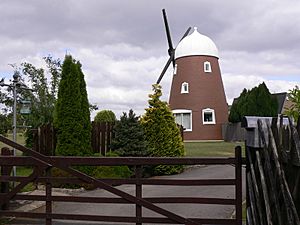Chalton Windmill facts for kids
Quick facts for kids Chalton Windmill |
|
|---|---|

Chalton Mill
|
|
| Origin | |
| Mill name | Chalton mill |
| Grid reference | SU 7160 1608 |
| Coordinates | 50°56′23″N 0°58′56″W / 50.9398°N 0.9822°W |
| Year built | Early 19th century |
| Information | |
| Purpose | Corn mill |
| Type | Tower mill |
| Storeys | Four storeys |
| No. of sails | Four sails |
| Type of sails | Patent sails |
| Windshaft | Cast iron |
| Winding | Fantail |
Chalton Windmill is a historic tower mill located on top of Windmill Hill in Chalton, Hampshire, England. It is a Grade II listed building, which means it's an important historical site. Today, it has been changed into a home.
History of Chalton Windmill
People have known about a mill on this spot for a very long time. Records show a mill here as early as 1289. Many old maps from the 1600s also show a windmill in this exact place.
The windmill you see today was built in the early 1800s. It worked for many years, helping to grind corn into flour.
In the 1950s, there was a plan to tear down the windmill. But the local council stepped in to protect it. They put a special order on the mill to make sure it would be saved.
Around 1978, permission was given to turn the mill into part of a new house. The people who converted it did a great job. They even won a special award from the Petersfield Society for their work.
What is a Tower Mill?
Chalton Windmill is a type of mill called a tower mill. This means it has a tall, round stone or brick tower. The top of the tower, called the cap, can turn to face the wind. This is different from older wooden windmills.
The Chalton mill had four large sails. These were "patent sails," which were special because they could be adjusted automatically. This made it easier for the miller to control the mill's speed.
A strong iron rod, called a windshaft, connected the sails to the machinery inside. A "fantail" on the back of the cap helped turn the whole top of the mill. This kept the sails facing the wind, so the mill could always work efficiently.
Inside the mill, there were large grinding stones. These stones were used to crush corn and other grains into flour. The millstones at Chalton worked from the top, which is called "overdrift."

